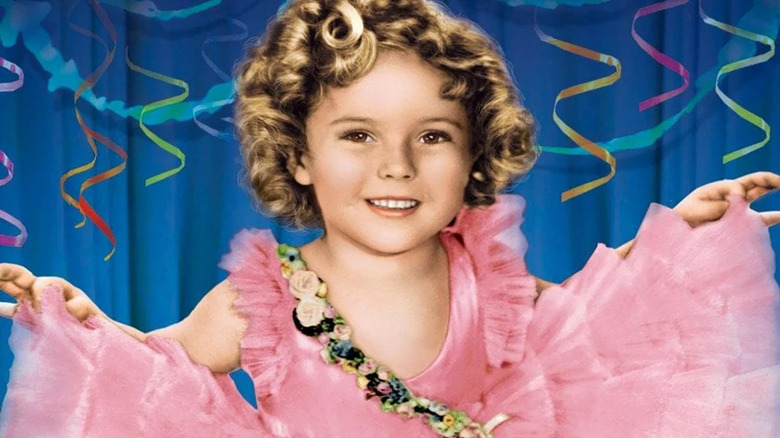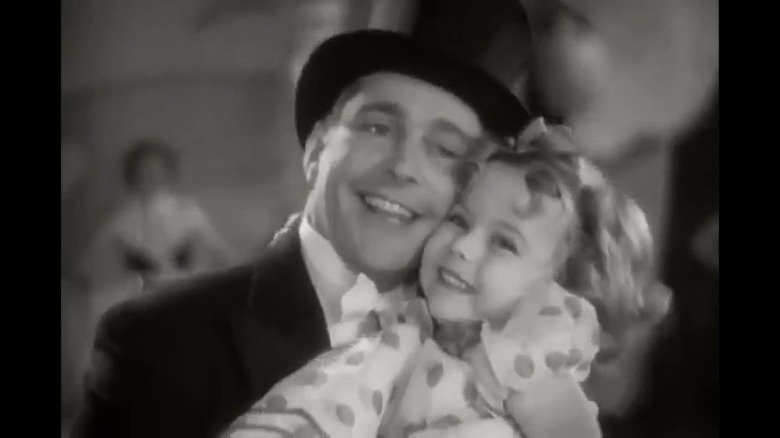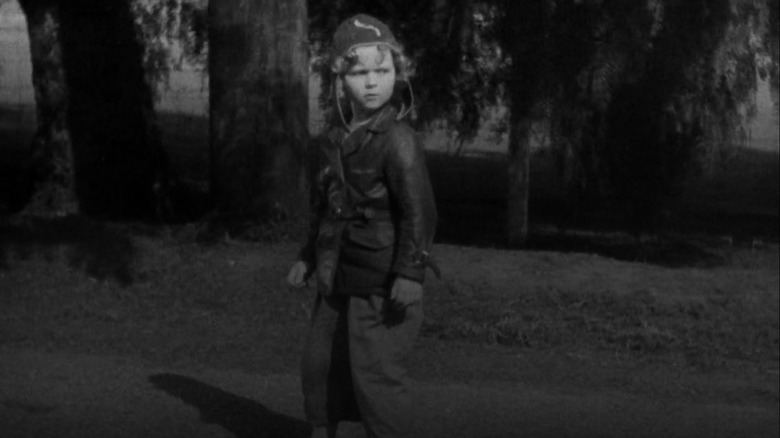How A Six Year Old Shirley Temple Saved Fox From Bankruptcy
In Hamilton McFadden's 1934 film "Stand Up and Cheer!," the unnamed off-screen president (actually Franklin D. Roosevelt) posits that the real reason for Great Depression was a sudden crisis of optimism. Additionally, wicked bankers were running amok and getting rich while the rest of the nation starved, leaving everyone nihilistic and horrified. The wasteful and corrupt Warren Harding administration followed by the Crash of '29 isn't mentioned, as McFadden's film sought to cheer people up, not make their depression — and the Depression — any worse. In "Stand Up and Cheer!," FDR created a Department of Amusement and appoints a secretary (Warner Baxter) to oversee a feel-good, nationwide show to keep morale up.
The bulk of the 80-minute film is a series of auditions in the secretary's office wherein performers come in to sing and dance, effectively turning the movie into a revue. Modern audiences may bristle at some racist caricatures, notably actress Tess Gardella performing in blackface as her Vaudeville persona "Aunt Jemima." Know that both Gardella and the maple syrup company took the name Aunt Jemima from an 1875 minstrel show song.
But there was one notable number — and one notable performer — that makes "Stand Up and Cheer!" historically significant. Singing a song called "Baby Take a Bow" were Vaudevillian James Dunn and his partner, a six-year-old Shirley Temple. The story goes that Temple had only signed a two-week, $150 contract and that she had to reuse a dance routine she had learned for a previous performance. Temple was sensational, however, and Fox knew they had a good thing when they saw it. As soon as shooting wrapped, Temple was brought to the office to extend her contract by seven years.
Those seven years made millions for Fox and cemented Temple as a permanent figure in popular culture.
Baby Take a Bow
Temple was charming, assured, and possessed of a cute childlike smile that audiences gravitated to. Her famous spitcurl was evidently fashioned at the last minute on the set of "Stand Up and Cheer!," after the girl fell and cut her head. The curl became a signature part of her look. She was only six, but Temple was an overnight movie star. According to a 2018 article in the Atlantic, Temple started with only $150 a week (about $3,600 in 2024 dollars), but six months later, was given a raise to $1,000 a week with a $15,000 bonus for each finished film. She was assigned 19 writers to give her scripts.
After "Cheer!," naturally Temple and Dunn were reteamed for Harry Lachman's "Baby Take a Bow," a film released less than two months after "Stand Up and Cheer!" In December of 1934, Temple starred in David Butler's "Bright Eyes," a film that was written specifically for her. That was the film to feature "On the Good Ship Lollipop," the girl's signature song. She was officially a national sensation. Fox officially had a "sure thing" that they could rely on to make money throughout the financially bleak 1930s. Temple was just a six-year-old who could sing and dance.
The reason Temple was paid so much was because of her parents' wise handling of her career. Fox was happy to exploit the image of their new cash-raking moppet, and plastered Temple's face on advertising materials ... without Temple's or her parents' consent. The Temples hired a lawyer, sent out hundreds of cease-and-desist letters, and put control of the oncoming Temple fortune directly into their hands. Luckily, Temple's parents had her best interests at heart.
The Good Ship Lollipop, traveling at warp speed
Temple was perhaps one of the busiest performers in Hollywood from 1935 to 1938. During that time, her films were outgrossing those of other notable matinee idols like Clark Gable, Joan Crawford, and Bing Crosby. After "Bright Eyes" through the end of '38, Temple starred in 18 feature films, including massive hits like Irving Cummings' "Curly Top" and "Poor Little Rich Girl," Allan Dwan's adaptation of "Heidi," and "Little Miss Broadway." The Atlantic article pointed out that Temple was earning more money at this time than anyone in Hollywood, save super-producer Louis B. Mayer. Temple also signed on to numerous endorsement deals, hawking Corn Flakes and Bisquick. She wasn't yet 10.
By 1939, Temple's star started to wane, although she remained a top-10 star for a few more years. Temple's contract with Fox expired in 1941 when the actress was 12. She signed a contract with MGM, but only made one film for the studio after fending off a gross sexual advance from producer Arthur Freed. She made a few more films in her teen years, but officially retired from showbiz in 1950 at the age of 21. She was a very wealthy woman. Temple would go on to be an international ambassador to Ghana and Czechoslovakia and serve in the Ford administration. She passed in 2014.
Why was Temple such a sensation during the Depression? It's likely audiences, tired of the misery of America's poverty, were moved by the image of a happy, healthy child singing and dancing. Temple's perceived innocence was like a protective bubble from the horrors outside, a smiling face that was oblivious to famine. Like the grenadine-based drink that bears her namesake, she was just sweet and bubbly. It was enough for the public.


